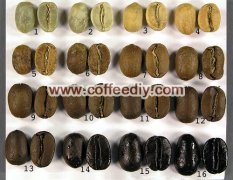Coffee Common sense Coffee processing methods and Flavor advantages and disadvantages of Coffee beans
The coffee beans we are familiar with are all cooked coffee beans, that is, roasted coffee beans. Different roasting processes can add different flavors to coffee beans. Perhaps few coffee lovers know the processing methods of raw coffee beans. Today, the editor will explain the processing methods and flavor advantages and disadvantages of raw coffee beans.
The harvested coffee fruit must enter the treatment program immediately, otherwise it will begin to ferment, making the coffee beans have a bad smell. Generally speaking, the processing methods of raw coffee beans are roughly divided into two kinds: one is "washing method" and the other is "drying method".
First, washing method: the treatment of washed coffee beans originated in Colombia, washing requires the use of special machinery and equipment and adequate water sources. When properly treated, the special characteristics of coffee beans can be more highlighted. In addition, the number of bad beans can also be removed in the washing process, so that the quality of coffee beans can be improved. The procedure of washing coffee is widely used in Central and South American countries.

The picture shows that raw coffee beans are processed by washing.
The raw coffee beans treated by water washing will have distinct acidity and consistent flavor. in the process of washing, the pulp is immediately separated from the raw beans instead of drying them. The steps are as follows:
1. Selection: put the fruit in the sink and let stand for about 24 hours. Mature and immature are classified by sinking and floating respectively because of the difference in density.
two。 Remove the pulp: the coffee fruit enters the pulp removal machine by water, the coffee beans and pulp are separated and spit out from two different outlets, and the pulp and skin floating on the surface are taken away by the water.
3. Fermentation: coffee beans are stored in a fermentation tank for about a day to ferment and peel off the remaining pulp, which, by the way, dissolves the slime on the surface of the coffee beans.
4. Washing: fully wash in the washing field.
5. Drying: dry for several days, when the sun can be delayed for a few days even if it is rainy.
As the water washing method can maintain more flavor of coffee beans, most of the high-quality coffee beans are treated by water washing, so coffee friends can pay attention to its treatment methods when buying single coffee beans, preferably by washing, so it is possible to keep the original taste. Note that the color of washed coffee beans will be more turquoise or grayish green. This helps us to distinguish when buying raw coffee beans.
two。 Drying method: the acidity of coffee treated by drying method is low, and there are many changes in flavor. So dried raw coffee beans are commonly used in blending coffee (how to mix coffee beans). The specific processing flow is as follows:
1. Selection: use the same method as washing to separate ripe beans from immature beans.
2 drying: tile in the drying field for sun drying. It usually takes 1-2 weeks, and because it takes a long time, special attention must be paid to climate change. In addition, coffee beans must be raked regularly every day to prevent fermentation, and coffee beans can be dried evenly. The water content of dried secondary beans decreased to about 12%.
3. Shelling: the dried coffee beans are sent to the sheller to remove the shell.
At present, except for parts of Brazil and Ethiopia, the vast majority of Arabica species are treated by water washing, while only some parts of Indonesia are treated by water washing, and almost all others are treated by drying.
Important Notice :
前街咖啡 FrontStreet Coffee has moved to new addredd:
FrontStreet Coffee Address: 315,Donghua East Road,GuangZhou
Tel:020 38364473
- Prev

Coffee common sense the advantages and disadvantages of drinking coffee frequently
Maybe you also like coffee like the editor, like the strong aroma of coffee, like the bitter aftertaste of the entrance, maybe you can drink three cups of Espresso a day like the editor, everything has a degree, drinking too much coffee will do certain harm to your health, do you know the advantages and disadvantages of drinking coffee often? The benefits of drinking coffee regularly: 1. Coffee contains certain amounts of
- Next

High-quality coffee beans common sense why coffee beans produce oil?
People who like to grind their own coffee beans have this feeling that there will be a layer of oil-like substance on the surface of coffee beans, which is called coffee oil, but in fact, this layer of oil-like substance is not coffee oil, so why do coffee beans produce oil? The changing process of oil production of coffee beans the oil evenly distributed on the surface of coffee beans is actually not oil, but a seemingly oil.
Related
- Beginners will see the "Coffee pull flower" guide!
- What is the difference between ice blog purified milk and ordinary milk coffee?
- Why is the Philippines the largest producer of crops in Liberia?
- For coffee extraction, should the fine powder be retained?
- How does extracted espresso fill pressed powder? How much strength does it take to press the powder?
- How to make jasmine cold extract coffee? Is the jasmine + latte good?
- Will this little toy really make the coffee taste better? How does Lily Drip affect coffee extraction?
- Will the action of slapping the filter cup also affect coffee extraction?
- What's the difference between powder-to-water ratio and powder-to-liquid ratio?
- What is the Ethiopian local species? What does it have to do with Heirloom native species?

